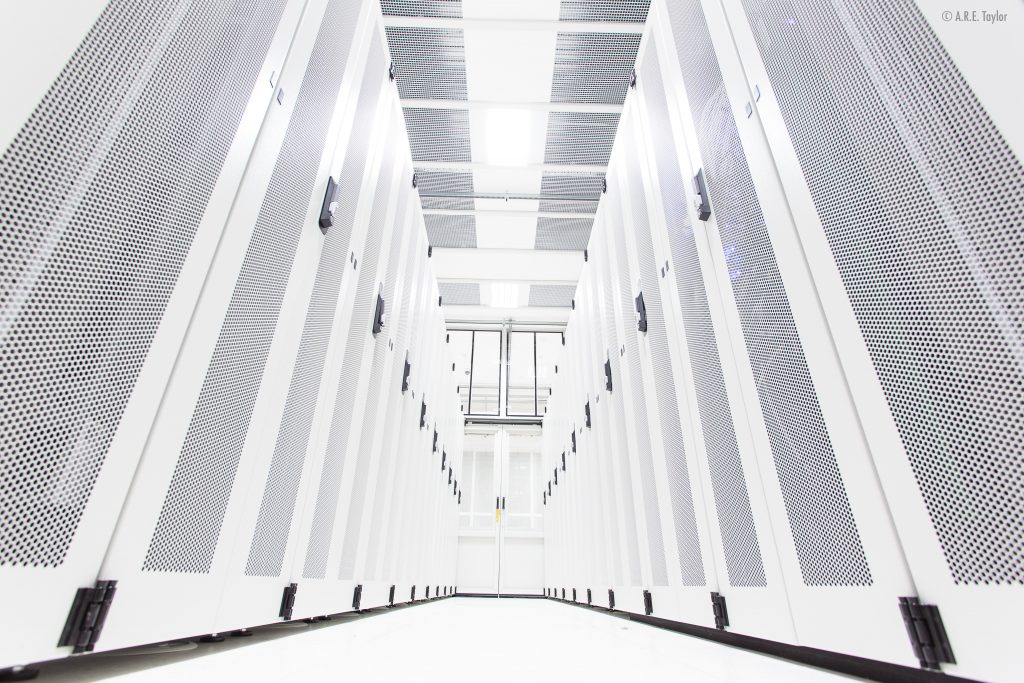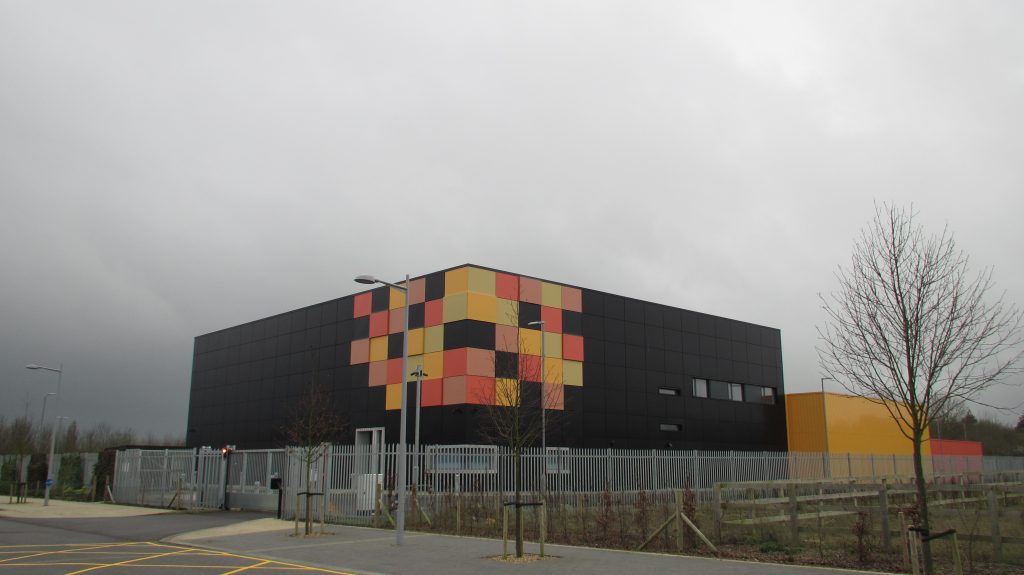by Emanuela Vai, University of Oxford, and A.R.E. Taylor, University of Exeter
What is the environmental impact of the digital humanities? This might seem like an odd question to ask. We often think of digital media as immaterial and ethereal. Digital services are persistently imagined as ‘virtual’ processes running on ethereal ‘clouds’. For this reason, the digital is persistently presented as a green and environmentally-friendly solution (we see this most presciently in the marketing rhetoric of the banking sector, where customers are encouraged to take climate action by switching to paperless statements).

Fig. 1 Server cabinets in a data centre, where digital humanities research data is often stored. Photo by A.R.E. Taylor
Popular imaginaries of digital technologies often turn around their immaterial and transcendental properties. Indeed, ‘[d]igitisation is often presented as a process of dematerialisation’ (Taylor 2022: 216). This was perhaps best characterised by MIT technologist Nicholas Negroponte (1995: 4), who famously described digitisation as a shift ‘from atoms to bits’. Of course, to view the process of digitisation this way is to problematically overlook the ‘stuff of bits’ (Dourish 2017) – from the atoms of which computing equipment is comprised, to the material infrastructure that lies behind the screen. The internet, in particular, has been persistently dematerialised in popular discourses and imaginaries, often presented as an ‘electronic world’, ‘cyberspace’ or an ‘information superhighway’ (Mosco 2004). Today the ‘cloud’ metaphor continues this conceptual history of imagining the internet as an immaterial, weightless and ethereal nonplace.
This rhetoric erases any sense of the materiality of the digital and, by extension, renders the geopolitical, social and environmental costs of digital cultures largely invisible. Digital technologies and services have a substantial carbon footprint but there remains a deficit of public knowledge about the carbon costs of the digital, from the carbon-emitting supply chains that underpin technology production to the fossil fuel-powered network infrastructure that digital services rely on.
This has implications for the digital humanities. Like all academic disciplines, the digital humanities has a carbon footprint. The advanced computational technologies that underpin DH research - from 3D scanners and printers to VR headsets to holographic imaging kits - are complex assemblages of embodied carbon. They are typically manufactured from rare-earth materials, which are often mined from regions in the Global South that are experiencing high rates of deforestation in order to expand mineral extraction (Cubitt 2016). As media archaeologist Jussi Parikka (2013) notes, ‘Our electronics are like mini-mines of minerals and metals […] copper, gold, lead, mercury, palladium and silver among other metals […] there would be no media without geology.'
Digital technologies also have limited lifespans. Big tech business models are driven by design logics like ‘planned obsolescence’, which encourages and often requires users to regularly upgrade, discard and replace digital devices (Taylor 2023). This leads to a build-up of electronic waste (‘e-waste’), which is often transported to countries in the Global South, where toxic chemicals leach into soil and water reserves. Agbogbloshie in Ghana is one of the world’s largest e-waste dumps. Thousands of discarded electronic and electrical devices (DEEDs) make for a toxic site where social and environmental justice issues intersect (Little 2021).
Beyond these carbon-emitting supply and discard chains, internet infrastructure predominantly runs on fossil fuels. The ‘virtual’ objects of the digital humanities, from scanned manuscripts to 3D models, rely on a vast physical infrastructure of data servers, fibre optic cables, power grids, and microwave links. Data centres provide the infrastructural backbone of the internet and, by extension, the digital humanities. It is on servers inside these warehouse-scale data processing facilities that the data, apps and online services that underpin digital projects are often located.

Fig. 2 The University of Cambridge’s data centre. Photo by A.R.E. Taylor

Fig. 3 Inside the University of Exeter’s data centre. Photo by A.R.E. Taylor
Data centres have facilitated new forms of remote data storage, access and processing, often brought together under the term ‘cloud’ computing. At its most basic, cloud computing refers to an infrastructural shift from desktop computing (where files and applications were stored on the local hard drives of a user’s computer) to a form of online computing (where these are stored in data centres that are accessed remotely ‘as a service’ through the internet). These buildings take up large tracts of land and consume vast amounts of energy and water resources to keep their facilities running and to stop their computing equipment from overheating (Hogan 2015; Moro 2021; Taylor 2021). To power and cool their IT equipment an average data centre consumes an estimated 200-terawatt hours of electricity each year, around 1% of total global electricity demand (Mytton 2020: 701), which is more than the national energy consumption of some countries (Jones 2018: 163). A 2012 Greenpeace report concluded that ‘If the cloud were a country, it would have the fifth largest electricity demand in the world’ (Greenpeace 2012: 10). The data centre industry has seen significant developments in energy efficiency since 2012 (from transistor density within integrated circuits, to data centre compute and storage, to GPU performance-per-watt). However, as media scholar Laura Marks (2020) has observed, these efficiency gains have largely occurred in tandem with an acceleration in data centre usage. As such, despite efficiency savings, overall energy consumption remains high.
Metaphors like the ‘cloud’ present digital platforms as detached from planetary ecologies and problematically erase any sense of the material infrastructure and associated carbon emissions of digital services (Taylor 2020; Ortar et al. 2022). Cultural commentators have noted that the metaphorical conceit of the cloud presents online data storage as a transcendental and placeless operation (Carruth 2014). As Arjun Appadurai and Neta Alexander (2020: 16) have observed of cloud computing companies: ‘the language of immateriality [is] often used to disguise their energy-consuming and environmentally destructive infrastructures’.
Other network infrastructure, such as the fibre optic cables and telecommunications towers through which data circulates, also require energy and can have significant local impacts on the environments, landscapes and ecologies in which they are embedded. Fibre-optic cables run through a range of marine environments and protected habitats, and their construction and deployment can have considerable social and environmental impacts (Starosielski 2015).
It is estimated that these digital technologies and their supporting infrastructure now account for more than 2% of global carbon emissions, putting information and communications technologies (ICTs) on a par with the aviation industry’s greenhouse gas emissions (Jones 2018). By 2030, it has been predicted that digital technologies could consume 51% of global electricity and produce 23% percent of greenhouse gas emissions (Andrae and Edler 2015). It should be highlighted that estimates for data centre energy consumption and for assessing the carbon emissions of ICTs more generally are quickly outdated and can range by an order of magnitude depending on the methodology employed and the data consulted (Koomey and Masanet 2021; Mytton and Ashtine 2022; Pasek et al. 2023). More work thus needs to be done on improving the methods, metrics and data of sustainability assessment tools.
In 2014 DH scholar Bethany Nowviskie asked ‘What is the place of digital humanities (DH) practice in the new social and geological era of the Anthropocene?’ Given the climate emergency and the carbon footprint of digital technologies, addressing the issue of environmental sustainability in the digital humanities is an urgent problem. There is now a growing body of DH scholars engaging with environmental questions. Of particular note is the Digital Humanities Climate Coalition, a collaborative and cross-institutional initiative focused on understanding and minimising the environmental impact of DH research through the development of various working groups and toolkits. Those of us who work in this interdisciplinary field have a responsibility to confront this issue, raise awareness, and develop climate-conscious practices. This must necessarily begin by reimagining the digital as material and as problematically entangled in myriad forms of carbon-generating activity.
About the Authors
Emanuela Vai is Senior Research Fellow and Head of Research at Worcester College, University of Oxford, and Keeper of the Bate Collection of Musical Instruments. She is the founder and academic lead of the Digital Humanities and Sensory Heritage (DHSH) Network and the PI of an EU Horizon Global Challenges Cofund project on digital humanities and heritage.
A.R.E. Taylor is a digital anthropologist based at the University of Exeter, where he is leading a project investigating the environmental impact of IT infrastructure in the Higher Education sector. His research on the carbon footprint of the data centre industry during the pandemic informed the Channel 4 Dispatches documentary ‘Is Your Online Habit Killing the Planet?’, which can be streamed via BoB (Box of Broadcasts) here.
Acknowledgements
This project has received funding from the European Union’s Horizon 2020 research and innovation programme under the Marie Skłodowska-Curie grant agreement No 945361.
Bibliography
Andrae, A.S.G. and T. Edler (2015) ‘On Global Electricity Usage of Communication Technology: Trends to 2030’. Challenges, 6(1): 117-157.
Appadurai, A. and N. Alexander (2020) Failure. Cambridge: Polity Press.
Carruth, A. (2014) ‘The Digital Cloud and the Micropolitics of Energy’. Public Culture,26: 339–364.
Cubitt, S. (2016) Finite Media: Environmental Implications of Digital Technologies. Durham, North Carolina: Duke University Press.
Dourish, P. (2017) The Stuff of Bits: An Essay on the Materialities of Information. Cambridge, Massachusetts: The MIT Press.
Greenpeace (2012) ‘How clean is your cloud?’ Amsterdam: Greenpeace International.
Hogan, M. (2015) ‘Data Flows and Water Woes: The Utah Data Center’. Big Data & Society, 2(2): 1–12.
Jones, N. (2018) ‘How to Stop Data centres from Gobbling up the World's Electricity’. Nature, 561: 163-167.
Koomey, J. and E. Masanet (2021) 'Does not compute: Avoiding pitfalls assessing the Internet's energy and carbon impacts'. Joule, 5: 1625-1633.
Little, P.C. (2021) Burning Matters: Life, Labor, and E-Waste Pyropolitics in Ghana. Oxford: Oxford University Press.
Marks, L.U. (2020) ‘Let’s Deal with the Carbon Footprint of Streaming Media’. Afterimage, 47(2): 46-52.
Moro, J. (2021) ‘Air-Conditioning the Internet: Data Center Securitization as Atmospheric Media’. Media Fields Journal: Critical Explorations in Media and Space. Available online: http://mediafieldsjournal.org/air-conditioning-the-internet/2021/4/26/air-conditioning-the-internet-data-center-securitization-as.html
Mosco, V. (2004) The Digital Sublime: Myth, Power, and Cyberspace. Cambridge, MA: MIT Press.
Mytton, D. (2020) ‘Hiding Greenhouse Gas Emissions in the Cloud’. Nature Climate Change, 10: 701.
Mytton, D. and M. Ashtine (2022) 'Sources of data center energy estimates: A comprehensive review'. Joule, 6: 2032-2056.
Negroponte, N. (1995) Being Digital. New York: Knopf.
Nowviskie, B. (2014) ‘Digital Humanities in the Anthropocene’. Digital Scholarship in the Humanities, 30(1): i4–15.
Ortar, N., A.R.E. Taylor, P. Brodie, A. Johnson, C. Marquet, A. Pollio and L. Cirolia (2022) 'Powering ‘Smart’ Futures: Data Centers and the Energopolitics of Digitalisation'. In: Energy Futures: Anthropocene Challenges, Emerging Technologies and Everyday Life. Edited by Sarah Pink, Simone Abram, Nathalie Ortar and Karen Waltorp. Berlin: De Gruyter, pp. 125-167. Available online: https://www.degruyter.com/document/doi/10.1515/9783110745641-005/html
Parikka, J. (2013) ‘The Geology of Media’. The Atlantic. Available online: https://www.theatlantic.com/technology/archive/2013/10/the-geology-of-media/280523/
Pasek, A., H. Vaughan and N. Starosielski (2023) 'The world wide web of carbon: Toward a relational footprinting of information and communications technology's climate impacts'. Big Data & Society, 10(1): 1-14.
Starosielski, N. (2015) The Undersea Network. Durham, North Carolina: Duke University Press.
Taylor, A.R.E. (2020) ‘Why Going Digital in Pandemic Times Might Not Be As Green As You Think’. Corona Times. Available online: https://www.coronatimes.net/going-digital-not-as-green-covid-19/
Taylor, A.R.E. (2021) ‘Standing by for Data Loss: Failure, Preparedness and the Cloud’. Ephemera: Theory and Politics in Organisation, 21(1): 59-93. Available online: https://ephemerajournal.org/contribution/standing-data-loss-failure-preparedness-and-cloud
Taylor, A.R.E. (2022) ‘Cloudwork: Data Centre Labour and the Maintenance of Media Infrastructure’. Routledge Companion to Media Anthropology. Edited by Elisabetta Costa, Patricia G. Lange, Nell Haynes, Jolynna Sinanan, pp. 213-228. Available online: https://www.taylorfrancis.com/chapters/oa-edit/10.4324/9781003175605-21/cloudwork-taylor?context=ubx&refId=445af9eb-d964-44f3-9d09-cb2943d7ab97
Taylor, A.R.E. (2023) Cloud Backup and Restore: The Infrastructure of Digital Failure. Routledge International Handbook of Failure: Critical Perspectives from Sociology and Other Social Sciences. Edited by Mikołaj Pawlak, Anna Horolets and Paweł Kubicki. London and New York: Routledge, pp. 223-236. Available online: https://tandfbis.s3.us-west-2.amazonaws.com/rt-files/docs/Open+Access+Chapters/9780429355950_10.4324_9780429355950-20.pdf
